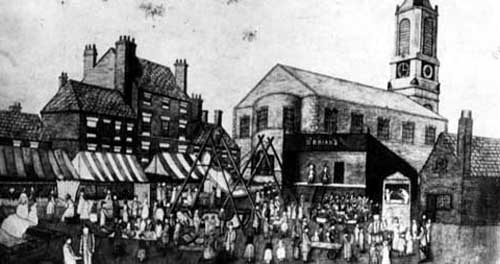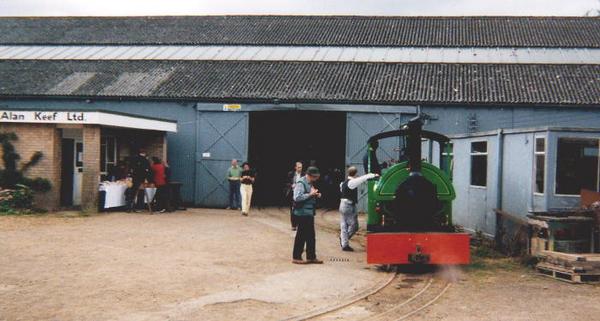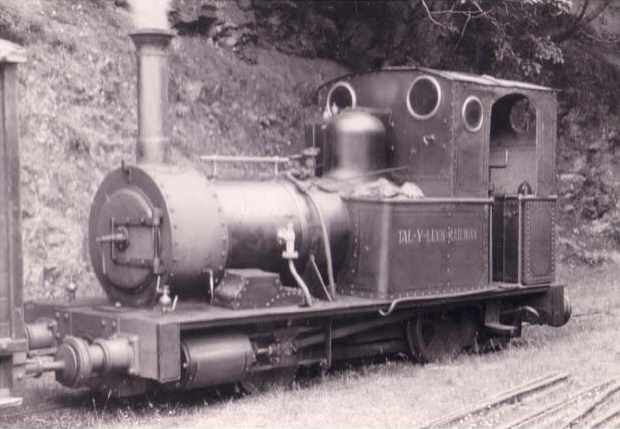|
Inny Valley Railway
The Inny Valley Railway was a private narrow gauge railway located at Trebullett, near Launceston in Cornwall, England. The railway was established by James Evans and ran around a field adjoining a workshop for the railway and a mill. Steam locomotives based at the railway were ''Velinheli'' built by Hunslet in 1886 and ''Sybil'' built by W.G. Bagnall in 1906, both previously in use at the Dinorwic Quarry. There was also a diesel locomotive built by Motor Rail and a passenger carriage built using redundant church pews. After closure the steam locomotives and carriage went to the Launceston Steam Railway whilst the diesel locomotive went to Alan Keef See also * British narrow gauge railways There were more than a thousand British narrow-gauge railways ranging from large, historically significant common carriers to small, short-lived industrial railways. Many notable events in British railway history happened on narrow-gauge railwa ... References * 1 ft 10¾ ... [...More Info...] [...Related Items...] OR: [Wikipedia] [Google] [Baidu] |
England
England is a country that is part of the United Kingdom. It shares land borders with Wales to its west and Scotland to its north. The Irish Sea lies northwest and the Celtic Sea to the southwest. It is separated from continental Europe by the North Sea to the east and the English Channel to the south. The country covers five-eighths of the island of Great Britain, which lies in the North Atlantic, and includes over 100 smaller islands, such as the Isles of Scilly and the Isle of Wight. The area now called England was first inhabited by modern humans during the Upper Paleolithic period, but takes its name from the Angles, a Germanic tribe deriving its name from the Anglia peninsula, who settled during the 5th and 6th centuries. England became a unified state in the 10th century and has had a significant cultural and legal impact on the wider world since the Age of Discovery, which began during the 15th century. The English language, the Anglican Church, and Engli ... [...More Info...] [...Related Items...] OR: [Wikipedia] [Google] [Baidu] |
Narrow Gauge Railway
A narrow-gauge railway (narrow-gauge railroad in the US) is a railway with a track gauge narrower than standard . Most narrow-gauge railways are between and . Since narrow-gauge railways are usually built with tighter curves, smaller structure gauges, and lighter rails, they can be less costly to build, equip, and operate than standard- or broad-gauge railways (particularly in mountainous or difficult terrain). Lower-cost narrow-gauge railways are often used in mountainous terrain, where engineering savings can be substantial. Lower-cost narrow-gauge railways are often built to serve industries as well as sparsely populated communities where the traffic potential would not justify the cost of a standard- or broad-gauge line. Narrow-gauge railways have specialised use in mines and other environments where a small structure gauge necessitates a small loading gauge. In some countries, narrow gauge is the standard; Japan, Indonesia, Taiwan, New Zealand, South Africa, and the Aust ... [...More Info...] [...Related Items...] OR: [Wikipedia] [Google] [Baidu] |
Trebullett
Trebullett is a hamlet in Cornwall, England, United Kingdom. It is about one mile west of Lezant Lezant ( kw, Lannsant) is a civil parish and village in east Cornwall, England, United Kingdom. Lezant village is about five miles (8 kilometres) south of Launceston. The population of the parish in the 2001 census was 751, increasing slightly t .... Another hamlet, Lower Trebullett, is further south.Ordnance Survey ''One-inch Map of Great Britain; Bodmin and Launceston, sheet 186''. 1961. References External links Hamlets in Cornwall {{Cornwall-geo-stub ... [...More Info...] [...Related Items...] OR: [Wikipedia] [Google] [Baidu] |
Launceston, Cornwall
Launceston ( or , locally or , kw, Lannstevan; rarely spelled Lanson as a local abbreviation) is a town, ancient borough, and civil parish in Cornwall, England, United Kingdom. It is west of the middle stage of the River Tamar, which constitutes almost the entire border between Cornwall and Devon. The landscape of the town is generally steep particularly at a sharp south-western knoll topped by Launceston Castle. These gradients fall down to the River Kensey and smaller tributaries. The town centre itself is bypassed and is no longer physically a main thoroughfare. The A388 still runs through the town close to the centre. The town remains figuratively the "gateway to Cornwall", due to having the A30, one of the two dual carriageways into the county, pass directly next to the town. The other dual carriageway and alternative main point of entry is the A38 at Saltash over the Tamar Bridge and was completed in 1962. There are smaller points of entry to Cornwall on minor ... [...More Info...] [...Related Items...] OR: [Wikipedia] [Google] [Baidu] |
Cornwall
Cornwall (; kw, Kernow ) is a historic county and ceremonial county in South West England. It is recognised as one of the Celtic nations, and is the homeland of the Cornish people. Cornwall is bordered to the north and west by the Atlantic Ocean, to the south by the English Channel, and to the east by the county of Devon, with the River Tamar forming the border between them. Cornwall forms the westernmost part of the South West Peninsula of the island of Great Britain. The southwesternmost point is Land's End and the southernmost Lizard Point. Cornwall has a population of and an area of . The county has been administered since 2009 by the unitary authority, Cornwall Council. The ceremonial county of Cornwall also includes the Isles of Scilly, which are administered separately. The administrative centre of Cornwall is Truro, its only city. Cornwall was formerly a Brythonic kingdom and subsequently a royal duchy. It is the cultural and ethnic origin of the Cornish dias ... [...More Info...] [...Related Items...] OR: [Wikipedia] [Google] [Baidu] |
Hunslet
Hunslet () is an inner-city area in south Leeds, West Yorkshire, England. It is southeast of the Leeds city centre, city centre and has an industrial past. It is situated in the Hunslet and Riverside (ward), Hunslet and Riverside ward of Leeds City Council and Leeds Central (UK Parliament constituency), Leeds Central parliamentary constituency. The population of the previous City and Hunslet council ward at the 2011 census was 33,705. Many engineering companies were based in Hunslet, including John Fowler & Co. manufacturers of traction engines and steam rollers, the Hunslet Engine Company builders of locomotives (including those used during the construction of the Channel Tunnel), Kitson & Co., Manning Wardle and Hudswell Clarke. Many railway locomotives were built in the Jack Lane area of Hunslet. The area has a mixture of modern and 19th century industrial buildings, terraced house, terraced housing and 20th century housing. It is an area that has grown up significantly a ... [...More Info...] [...Related Items...] OR: [Wikipedia] [Google] [Baidu] |
Motor Rail
Motor Rail was a British locomotive-building company, originally based in Lewes, Sussex, they moved in 1916 to Bedford. In 1987 loco manufacture ceased, and the business line sold to Alan Keef Ltd of Ross-on-Wye, who continue to provide spares and have built several locomotives to Motor Rail designs. History The origins of the Motor Rail company can be traced back to the patenting of a gearbox by John Dixon Abbott of Eastbourne in 1909 ("Change speed and reversing gearbox suitable for use in motor-trams", UK Patent 18314). In March 1911, he formed The Motor Rail & Tramcar Co Ltd, with his father John Abbott and brother Tom Dixon Abbott. The stated aim of the business was developing the gearbox and incorporating it in tramcars and railcars. At about the same time operations moved to Lewes, Sussex and rented space in the Phoenix Foundry of John Every, where they developed a narrow-gauge rail vehicle around the Dixon-Abbott gearbox using a twin cylinder water-cooled Dorman engin ... [...More Info...] [...Related Items...] OR: [Wikipedia] [Google] [Baidu] |
Launceston Steam Railway
The Launceston Steam Railway is a narrow gauge railway, in Cornwall, England. The railway operates from the town of Launceston to Newmills, where there is a farm park; it is long. The railway is built on the trackbed of the former standard gauge North Cornwall Railway. History Standard gauge railway The first railway to reach Launceston was the Launceston and South Devon Railway, opened in 1865 from Launceston to Plymouth, and later absorbed into the Great Western Railway. In 1886 the London and South Western Railway opened its railway from Halwill Junction, extended to Padstow in stages in the 1890s, and later part of the Southern Railway. The two Launceston stations were side by side: the Great Western closed in 1962 and the Southern in 1966. Narrow gauge revival In 1965, Nigel Bowman, a trainee teacher, rescued the steam locomotive ''Lilian'' from the Penrhyn Slate Quarry in North Wales, and restored her to working order at his home in Surrey. He then set about ... [...More Info...] [...Related Items...] OR: [Wikipedia] [Google] [Baidu] |
Alan Keef
Alan Keef Ltd is a British narrow gauge railway engineering company which manufactures, overhauls, and deals in narrow gauge locomotives, rolling stock and associated equipment. The Limited Company was formed in 1975 at Cote, Bampton, Oxon, continuing what Alan Keef had already been doing for some years as an individual. In 1986 the company moved to larger premises at Lea, near Ross-on-Wye in Herefordshire. The first new loco was built in 1976. To date (2008) over eighty locos have been built – steam, diesel and electric. Most have been miniature or narrow gauge except for two standard gauge steam locos for Beamish Museum – the replicas of " Steam Elephant" and " Puffing Billy". In 2008 Alan Keef Ltd built the frames, running gear and mechanical parts for two Parry People Mover railcars for use on the Stourbridge Town branch (139001 and 139002). A number of Alan Keef's locomotives are replicas of steam locomotives but with diesel power. These are referred to as ''stea ... [...More Info...] [...Related Items...] OR: [Wikipedia] [Google] [Baidu] |
British Narrow Gauge Railways
There were more than a thousand British narrow-gauge railways ranging from large, historically significant common carriers to small, short-lived industrial railways. Many notable events in British railway history happened on narrow-gauge railways including the first use of steam locomotives, the first public railway and the first heritage railway, preserved railway. History Early railways: before 1865 The earliest narrow-gauge railways were crude wooden trackways used in coal mines to guide wooden Quarry tub, tubs. Because of the restricted loading gauge of the tunnels and the need for the tubs to be small enough to be pushed by one man, these railways were almost all narrow gauge. These underground lines often had short above-ground sections as well. After the start of the Industrial Revolution it became possible to create railways with iron tracks and wheels, which reduced the friction involved in moving wagons and made longer horse-hauled trains possible. These could mov ... [...More Info...] [...Related Items...] OR: [Wikipedia] [Google] [Baidu] |
1 Ft 10¾ In Gauge Railways In England
1 (one, unit, unity) is a number representing a single or the only entity. 1 is also a numerical digit and represents a single unit of counting or measurement. For example, a line segment of ''unit length'' is a line segment of length 1. In conventions of sign where zero is considered neither positive nor negative, 1 is the first and smallest positive integer. It is also sometimes considered the first of the infinite sequence of natural numbers, followed by 2, although by other definitions 1 is the second natural number, following 0. The fundamental mathematical property of 1 is to be a multiplicative identity, meaning that any number multiplied by 1 equals the same number. Most if not all properties of 1 can be deduced from this. In advanced mathematics, a multiplicative identity is often denoted 1, even if it is not a number. 1 is by convention not considered a prime number; this was not universally accepted until the mid-20th century. Additionally, 1 ... [...More Info...] [...Related Items...] OR: [Wikipedia] [Google] [Baidu] |



.jpg)


